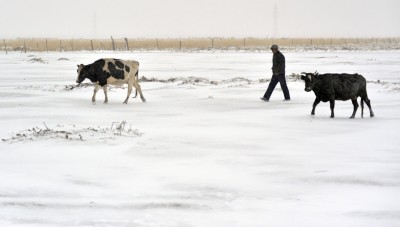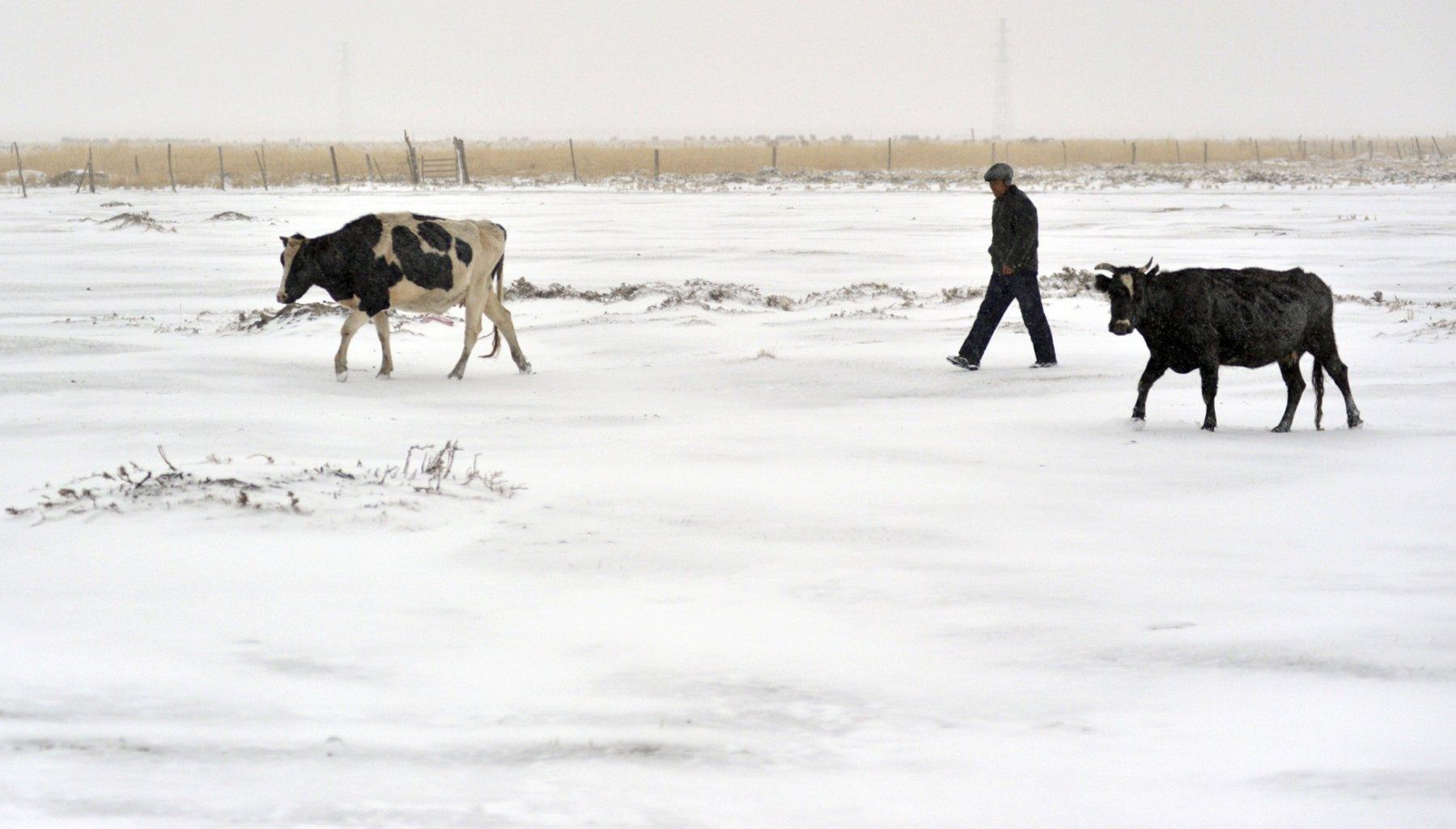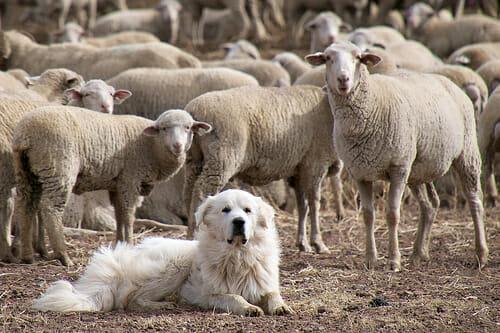
Caring for cattle requires dedication and hard work under the best of circumstances, but during long and frigid winter months, an even higher level of determination is required. For many people, winter chill can make normally pleasant chores miserable, and the thought of adding more work is enough to make any hard-working homesteader grit their teeth. If you take the time to implement proper precautions before the winds and snow hit your area, however, many of the problems and stress associated with the winter months can be minimized.
Planning For Winter
Winter Housing
Many homesteaders have limited or no access to facilities such as barns and milking parlors. While outdoor housing has many benefits and cows are very well-adapted to living on pastures, harsh winter weather will strain any dairy cow. To minimize this stress, start analyzing your pasture before the cold arrives, and create a winter plan accordingly.
The first thing to consider when wintering cows is the climate of your area. From which direction do storms and strong winds typically come? How much precipitation do you receive over the winter? Does this precipitation usually fall as snow, or as freezing rain and sleet?
If you live in a climate with low precipitation but significant wind chill, try to keep your cows in a valley protected from strong winds. Constructing wind fences is also a good option when natural wind barriers are not available. Wind fences can be permanent structures or portable fences that are designed to block 80 percent of the prevailing winds. A windbreak with this design will slow winds considerably and still remain sturdy during storms. Most windbreaks are between 8 and 12 feet tall, and are also useful (although expensive) snow barriers.
If you do not wish to build windbreakers, stacked bales of straw, large snow piles, or even parked tractors and other vehicles can serve as suitable windbreaks for all but the most severe winds.
Freezing rain is the biggest enemy of cows during winter, and if you experience frequent freezing rain you should consider constructing a shed, either three-sided or complete. The shed will have to be bedded at regular intervals, and building a portable shed may be a good idea. Although sheds provide excellent protection against excessive wetness, they will need to be well-ventilated and well-bedded to avoid trapping ammonia which can lead to respiratory problems.
Cows should have no difficulty handling snow, and often snow is a good insulator against extreme winds. As long as cows can continue to move comfortably and you are able to feed and milk, snow should not affect your cow negatively. Just be sure to put up snow fences or keep snow blowers in good condition if snowfall starts to restrict your and your cow’s mobility.
Produce all the food you need on just a quarter acre!
Bedding
Although cows have many admirable qualities, cleanliness certainly is not one of them. Thus, unlike most animals which have the good sense to stay out of their own waste, cows will actually lie in it during cold weather to keep warm. Of course, eventually the manure freezes, and the cow is left filthy and freezing if you cannot keep them from this tendency.
Due to this annoying habit, you will need to have bedding on hand to protect your cows from moisture and to keep them clean. Non-lactating cows may be fine without any bedding, but lactating cows can suffer frostbitten teats if they do not have a protected area on which to lie. Younger animals will need even heavier bedding as they are more likely to become chilled and suffer winter diseases. Woodchips or shavings, hay and straw all make excellent bedding material, and are relatively inexpensive options.
Winter water sources
Lactating cows need constant access to clean water, although their demand for water will go down with the temperature. This may come as a relief if the pressure to keep up with them during the summer was difficult, but with lower temperatures comes the different challenge of keeping available water thawed.
Different homesteaders have taken many approaches to this problem. If you are not averse to the extra work and temperatures are not too severe, chipping the ice away yourself is a simple option. Likely, the most popular way to keep water flowing is by using heated, insulated waterers or bubblers to keep waterers open. These devices are the best way to ensure water is always available, but if you are off-grid or generating your own electricity this may not be an option. Lastly, if you live in an area with constant snow cover, cows can become accustomed to using snow as their primary water source. This is not ideal, and you will likely see a decrease in milk production if using snow for water, but some farmers and homesteaders have successfully over wintered cows in this manner.
Any of these options will work well for dairy cows as long as the water is clean. Although it is true that cows tend to drink more if the water is warmed (thus yielding more milk over the traditionally lean winter months), if providing warm water is out of the question, cold water will be adequate. Be prepared to offer more feed if providing cold water, as it takes more energy for the cow to warm this water to body temperature.
Dry Off Your Cow
Although this is not always a solution, if you live in an area with harsh winters and high winds, you may want to avoid milking over winter if at all possible. The stress of coping with below-freezing temperatures affects all animals, but for a lactating dairy cow, the added nutritional requirements can be significant. Of course, avoiding milking is not always practical, since you may have had little control over the timing of calving, or you desire to continue your lactation for an extended period. Still, if you live in an area with mild summers and harsh winters, avoiding winter milking and calving in early spring might be the best option. Dry cows are fairly easy to care for as long as their nutritional requirements are met, and not having to care for young calves is an added boon.
Care During Winter
Udder Balms
One of the banes of winter milking is the fight against cracked and chapped skin. While winter weather can wreak havoc on your own skin, your dairy cow will also suffer from udder ailments if the udder is not kept dry and moisturized. Care should be taken to dry the udder thoroughly, and if your cow is leaking between milkings you will have to milk more frequently. If, despite your best efforts, the udder becomes chapped or raw, there are many commercial balms you can purchase that are highly effective in healing and moisturizing udders (not to mention your own abused hands).
Homegrown Dairy Products, Fresh from Your Yard!
If you want to make your own udder balm, there are many detailed recipes online from homesteaders that prefer not to purchase commercial products. My family makes udder balm out of beeswax, olive oil, and various essential oils, but have always “eyeballed” this process and thus no true recipe exists for our concoction. We have, however, experimented extensively with essential oils, and have found some that work quite well in udder balm:
- Lavender oil: Prized for its antibacterial activity, we include lavender oil in almost every salve we prepare.
- Tea tree oil: This oil also possesses antibacterial properties.
- Peppermint oil: Although we do not use it regularly, we have found it to be highly effective in clearing up all but the worst cases of mastitis.
- Calendula: Relieves skin inflammation.
Foot Care
Foot maintenance is an extremely important part of cow care. Cows on pasture typically have fewer foot problems than cows housed on concrete, but they are still susceptible to cracked and bruised feet, and can suffer from foot rot and warts. While it is important to watch for and treat feet problems during all months, it can be more difficult to observe foot ailments during the winter season. You will likely spend less time outside observing your cattle than you did during fair weather, and your cow will likely not be as active due to snow and ice, so limping may be harder to spot. Also, muddy conditions can lead to a higher incidence of foot problems and even the best caretaker cannot eradicate muddy spots during winter thaws. Thus, checking feet should become part of your winter chore routine if you want to keep your cow healthy and comfortable.
Winter Diseases
Winter is a prime time for diseases to flourish in all livestock, and dairy cows and calves are no exception. While there is no way to fully prevent winter outbreaks, there are some diseases that are common and should be assiduously watched for over winter:
- Viral and bacterial pneumonia: Any cow that is listless and depressed should be viewed as a possible case of pneumonia; an increased rate of respiration and loss of appetite are signs of more advanced pneumonia and should be treated very seriously. Pneumonia is most common during the late fall/early winter months. Keeping cows dry and well-ventilated is essential to preventing pneumonia, but if you suspect an animal has become ill, they will need veterinary care.
- Winter Dysentery: Although rarely fatal, winter dysentery is an alarming and rather unpleasant illness caused by bovine coronavirus. This disease causes extremely runny, blackish-green diarrhea, and blood may be present in the stool. You may also see a dramatic decrease in milk production. Although this disease does not usually require treatment, electrolytes and proper nutrition will improve recovery time. Winter dysentery can be minimized or avoided by keeping housing clean over the winter and moving feeding areas often.
- Bacterial Abortions: Your cow will be more susceptible to abortion-inducing agents over the winter, so if your cow is bred special care should be taken to keep her clean and healthy. Consult with your vet about potential threats in your area, and make sure to move feeding areas more frequently in order to reduce bacterial growth.
Although caring for cows during cold weather can seem like a challenge, once you are prepared the winter months can be extremely rewarding. Insects no longer pose a problem, and it is easier to keep milk sanitary in cold temperatures. Maintaining a positive attitude is vital during the long winter months, and if you are able to keep smiling through the cold, your dairy cow will reward you with fresh, wholesome milk through the long winter months. Hot cocoa will never taste better.











